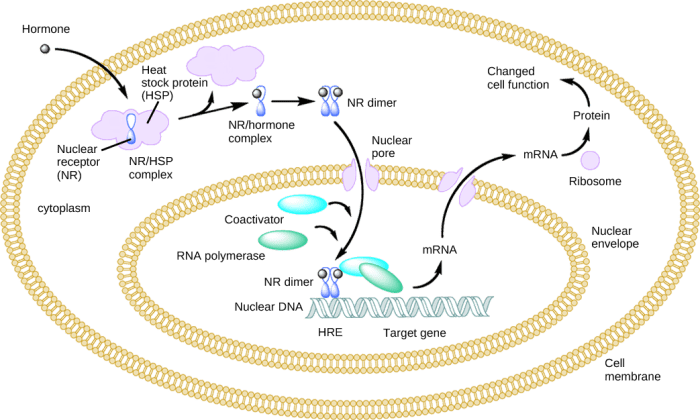As the figure above represents a generalized hormone signaling pathway takes center stage, this opening passage beckons readers into a world crafted with precision and clarity, ensuring a reading experience that is both absorbing and distinctly original.
Hormone signaling pathways are intricate networks that orchestrate cellular communication, shaping diverse physiological processes. This generalized pathway serves as a blueprint, illuminating the fundamental steps and components that govern hormone-mediated signal transduction.
Introduction to Hormone Signaling Pathways

Hormone signaling pathways are fundamental mechanisms that enable cells to communicate and coordinate physiological processes within multicellular organisms. These pathways involve the transmission of signals from endocrine glands or specialized cells to target cells, regulating various cellular activities and maintaining homeostasis.
A generalized hormone signaling pathway consists of several key components:
- Hormones:Chemical messengers that initiate the signaling process.
- Receptors:Proteins on the surface or within target cells that bind to specific hormones.
- Second messengers:Molecules that relay the signal from the receptor to the target cell.
- Target cells:Cells that respond to the hormone signal and undergo specific physiological changes.
Key Features of the Generalized Pathway
The generalized hormone signaling pathway involves a series of steps:
- Hormone release:Hormones are synthesized and released by endocrine glands or specialized cells.
- Hormone binding:Hormones bind to specific receptors on target cells.
- Signal transduction:The hormone-receptor interaction triggers a cascade of events that generate second messengers.
- Second messenger action:Second messengers activate target proteins, leading to cellular responses.
- Cellular response:Target cells undergo specific physiological changes, such as gene expression, protein synthesis, or metabolic regulation.
Hormone Binding and Receptor Activation
Hormones bind to receptors with high specificity, initiating signal transduction. There are two main types of hormone receptors:
- Cell surface receptors:Located on the plasma membrane, these receptors bind to hydrophilic hormones and trigger intracellular signaling.
- Intracellular receptors:Found within the cytoplasm or nucleus, these receptors bind to hydrophobic hormones and directly regulate gene expression.
Second Messenger Generation and Signal Amplification
Second messengers are molecules that amplify and relay the signal from the receptor to the target cell. Common second messengers include:
- Cyclic adenosine monophosphate (cAMP):Mediates the effects of hormones such as epinephrine and glucagon.
- Inositol trisphosphate (IP3):Triggers the release of calcium ions from intracellular stores.
- Diacylglycerol (DAG):Activates protein kinase C (PKC).
Target Cell Response and Biological Effects
Hormone signaling pathways lead to specific biological responses in target cells. These responses can include:
- Gene expression:Regulation of transcription and translation.
- Protein synthesis:Activation or inhibition of protein synthesis.
- Metabolic regulation:Alteration of metabolic pathways.
- Cell growth and differentiation:Control of cell division and specialization.
Regulation of Hormone Signaling
Hormone signaling pathways are tightly regulated to ensure appropriate cellular responses:
- Negative feedback loops:The end product of a pathway inhibits its own production or action.
- Desensitization:Prolonged exposure to a hormone can lead to decreased receptor sensitivity.
- Up-regulation and down-regulation:Changes in receptor number and affinity in response to hormone levels.
Examples of Hormone Signaling Pathways, The figure above represents a generalized hormone signaling pathway
| Hormone | Receptor | Second Messenger | Biological Effect |
|---|---|---|---|
| Epinephrine | Cell surface | cAMP | Increased heart rate, vasodilation |
| Insulin | Cell surface | PI3K | Glucose uptake, glycogen synthesis |
| Estrogen | Intracellular | ER | Gene expression, cell proliferation |
Applications and Therapeutic Implications
Understanding hormone signaling pathways has applications in medicine and drug development:
- Diagnosis:Measurement of hormone levels and receptor function can aid in diagnosing endocrine disorders.
- Treatment:Drugs can target specific components of hormone signaling pathways to treat diseases, such as hormone replacement therapy or antagonists.
- Drug development:Research on hormone signaling pathways can lead to the development of new therapies for various diseases.
Commonly Asked Questions: The Figure Above Represents A Generalized Hormone Signaling Pathway
What is the purpose of a hormone signaling pathway?
Hormone signaling pathways enable cells to communicate with each other over long distances, coordinating physiological responses and maintaining homeostasis.
How does a hormone bind to its receptor?
Hormones bind to specific receptors on the surface of target cells or within the cytoplasm. These receptors are proteins that have a specific binding site for the hormone.
What is the role of second messengers in hormone signaling?
Second messengers are molecules that relay the signal from the hormone-receptor complex to the target cell’s interior, amplifying and propagating the signal.


